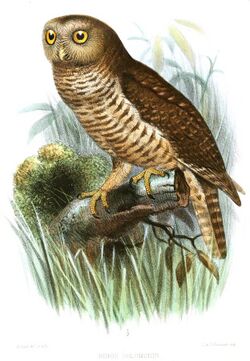Biology:New Ireland boobook
| New Ireland boobook | |
|---|---|

| |
| Scientific classification | |
| Domain: | Eukaryota |
| Kingdom: | Animalia |
| Phylum: | Chordata |
| Class: | Aves |
| Order: | Strigiformes |
| Family: | Strigidae |
| Genus: | Ninox |
| Species: | N. variegata
|
| Binomial name | |
| Ninox variegata (Quoy & Gaimard, 1832)
| |
| Synonyms | |
|
Noctua variegata (Quoy and Gaimard, 1830)[3] | |
The New Ireland boobook (Ninox variegata) also known as the Bismarck hawk-owl or Bismarck boobook, is a small to medium-sized owl measuring 25 to 30 cm (9.8 to 11.8 in) in length.[4] It is a dark rufous-brown above, with barred scapular feathers and variable amounts of spotting or barring on the wings and tail. Its underparts are whitish, with an unmarked pale throat, a dark barred upper breast and barring on the remainder of the underparts. Its face is dark brown, its eyes are brown or yellow, and its bill and legs are yellow.[5] It is short-tailed and has heavy tarsi (the part of the leg above what is commonly referred to as the foot).[6]
Endemic to the Bismarck archipelago, it occurs on the islands of New Britain, New Ireland and New Hanover,[3] where it lives in forested lowlands, hills and mountains, up to an altitude of 1,000 m (3,300 ft).[4]
It was first described as Noctua variegata by French naturalists Jean René Constant Quoy and Joseph Paul Gaimard in 1830.[3]
Although its population size has not been quantified, it is widespread and fairly common in forest and forest edges within its range, and its numbers are thought to be stable.[7] Deforestation is thought to be a likely threat to the species.[8]
References
- ↑ BirdLife International (2018). "Ninox variegata". IUCN Red List of Threatened Species 2018: e.T22689475A130164063. doi:10.2305/IUCN.UK.2018-2.RLTS.T22689475A130164063.en. https://www.iucnredlist.org/species/22689475/130164063. Retrieved 12 November 2021.
- ↑ "Appendices | CITES". https://cites.org/eng/app/appendices.php.
- ↑ 3.0 3.1 3.2 Sibley, Charles Gald; Monroe, Burt Leavelle (1990). Distribution and taxonomy of birds of the world. New Haven, CT: Yale University. p. 182. ISBN 0-300-04969-2.
- ↑ 4.0 4.1 4.2 Weick, Friedhelm (2002). Owls (Strigiformes): Annotated and Illustrated Checklist. Springer. p. 228. ISBN 3-540-35234-1.
- ↑ König, Claus; Weick, Friedhelm; Becking, J. H (1999). Owls: A Guide to the Owls of the World. Ithaca, NY: Pica Press. p. 184. ISBN 1408108844.
- ↑ Rasmussen, Pamela C (December 1999). "A New Species of Hawk-owl Ninox from North Sulawesi, Indonesia" (PDF). The Wilson Bulletin 111 (4): 457–464. http://sora.unm.edu/sites/default/files/journals/wilson/v111n04/p0457-p0464.pdf.
- ↑ "Bismarck Hawk-owl Ninox variegata". BirdLife International. http://www.birdlife.org/datazone/speciesfactsheet.php?id=2311&m=1.
- ↑ Newton, Ian, ed (2002). Ecology and conservation of owls. Csiro Publishing. p. 357. ISBN 0-643-06794-9.
Wikidata ☰ Q1265886 entry
 |


